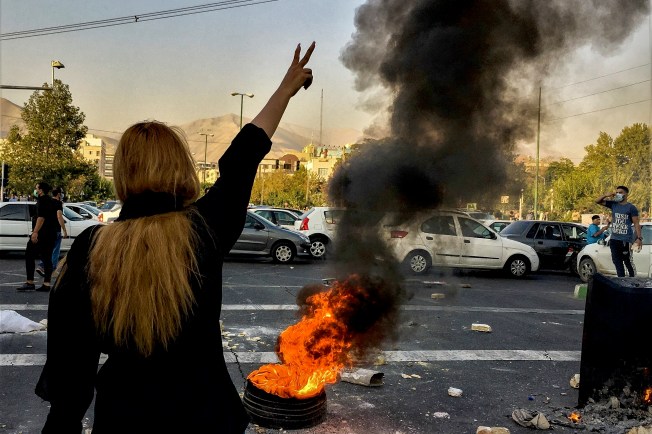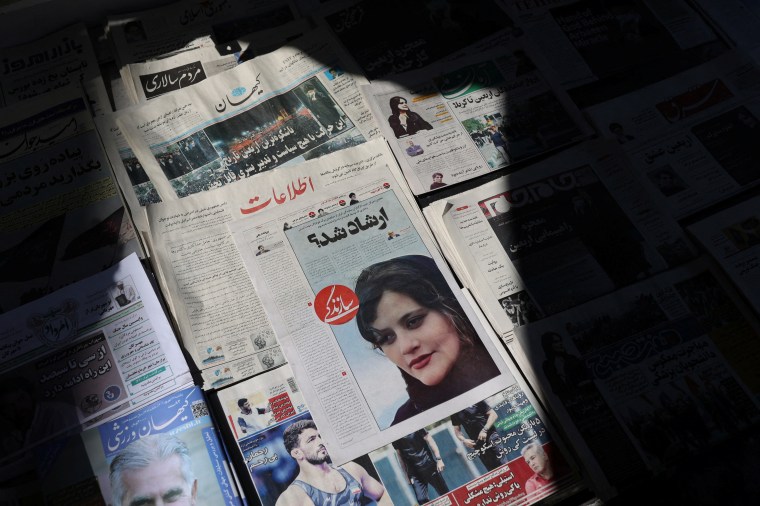When Mahsa (Jina) Amini, a 22-year-old Iranian Kurdish woman, died in custody last September after morality police detained her for alleged “improper” wearing of her headscarf, Iran’s already embattled press corps paid a heavy price for reporting on her death and the nationwide protests that followed. Scores of journalists were among those arrested as Iranian authorities cracked down on the demonstrators, leading Iran to be ranked as the world’s worst jailer of journalists in CPJ’s 2022 prison census.
One year later, the assault on the press – as well as on activists and Amini’s relatives – continues. Journalists and even their lawyers have faced punitive retaliation for their work, with a number of reporters making the hard decision to flee their country.
Inside Iran, journalists are “seen as a threat,” said Holly Dagres, an Iran analyst with the non-partisan U.S. think tank Atlantic Council, in an email to CPJ. “They help inform the populace about what is happening and uncover the truth. As a result, journalism is kryptonite to authoritarian governments because it can expose systemic issues and lead to them being held to some form of account.”
The full extent of Iranian authorities’ response to the protests remains hard to determine. Numerous journalists have been silenced and witnesses to brutality fear the consequences of speaking out. However, CPJ research and interviews with a range of sources inside and outside the country – most of whom asked to remain anonymous for fear of state retribution against them or their families – offer some insight about how the crackdown has affected Iran’s journalists and media outlets.
Here are some of the key trends identified by CPJ’s research:
Journalists are being charged with crimes against the state
Roughly 100 journalists, many of them women, are known to have been arrested in relation to their protest coverage. While most of them have been released on high bail, some have been rearrested. Authorities have charged nearly all with “spreading propaganda against the ruling system” and “colluding and acting against national security,” according to sources familiar with their cases who spoke to CPJ on the condition of anonymity, citing fear of reprisal. Under the Iranian penal code, propaganda convictions can carry a term of up to one year and collusion up to five years, but CPJ has learned of several journalists who were sentenced in excess of legal maximums, including extra prison time, lashes with a whip, bans on working or leaving the country, or mandatory community service.

Journalists Niloofar Hamedi, who helped break the story of Amini’s death, and Elahe Mohammadi, who reported on the funeral in Amini’s hometown, Saqqez, in Kurdistan province, were arrested in September 2022 and accused of espionage, which can carry the death penalty in Iran. They have been formally charged with colluding against national security for hostile states, including the United States, which can carry a 10 year prison sentence.
“Without their important contribution, ordinary Iranians would not be taking to the streets to demand ‘Women, Life, Freedom’ in [Amini’s] name and calls for the clerical establishment to fall,” said Dagres. “Their arrests ushered in the rise in repression against journalists in Iran.”
Authorities are singling out journalists for social media posts
When mainstream outlets censored their coverage of the protests in fear of retaliation, many journalists took to social media to express opinions and report on the news. In some cases, authorities have used those posts as evidence against reporters in interrogations and court hearings.
Ehsan Pirbornash, who covers sports news for the state-run Iran Varzeshii newspaper, was arrested in October and subjected to hours of interrogation during which authorities questioned him about social media posts on X (formerly Twitter) and Instagram. He was handed printouts of his posts and forced to explain his rationale for their content, including one in which he used the word “dictator,” he told the exile media outlet IranWire. Pirbornash was released on bail and sentenced to 18 years in prison and a ban on leaving the country, but was able to flee before he was taken into custody to serve his sentence. He now lives in Germany with his family, he told IranWire.
Journalists are being legally barred from reporting
Authorities have begun explicitly banning many reporters from practicing journalism as part of their sentences, simultaneously stripping them of their livelihood and depriving Iranians of essential information about what is happening in their country.
One journalist, Seyed Mostafa Jaffari, was arrested in July 2022 and sentenced to two years in prison and a two-year ban on practicing journalism. He had not yet begun serving his prison sentence in July 2023 when he was arrested again on charges of allegedly publishing false news. He has since been released on bail.
In another case, the editor-in-chief and publisher of Etemad newspaper, Behrouz Behzadi, a prominent veteran journalist, was banned from practicing journalism for one year on July 31 after the Islamic Revolutionary Guard Corps filed a complaint against him about the newspaper’s coverage of the roots of unrest in the country, according to Human Rights Activist News Agency, an exile-run media site.
Lawyers for journalists are also under threat
Lawyers of journalists have faced harassment. Mohammad Ali Kamfirouzi, who represented Mohammadi and Hamedi, received threats in the mail and over the phone, including a letter from authorities ordering him to stop his work, according to a source with knowledge of the case who spoke to CPJ on the condition of anonymity. Kamfirouzi was forced to drop his clients after he was arrested in December and was not able to represent them again after his release on bail the following month. Since then, Mohammadi and Hamedi’s cases have been taken up by other lawyers.
In May, Iran’s judiciary began summoning lawyers from around the country to sign a document agreeing to not accept certain clients accused of harming national security, a common charge facing journalists. In cases where lawyers are allowed to represent clients facing these charges, they cannot publicly share information about the cases. According to lawyers who spoke with CPJ on the condition of anonymity, lawyers who refuse to sign have been threatened with arrest or the revocation of their licenses.
A new generation of Iranian journalists has fled into exile
A growing number of Iranian journalists are fleeing the country to evade further persecution. Saeede Fathi, a freelance sports reporter, was arrested in October last year and released on bail in December. She is seeking asylum in Vienna, Austria, where she lives with her husband, and is trying to continue her reporting on Iranian female athletes. “I am currently trying to learn German and improve my English and I hope to be able to be the voice of women and advocate for my colleagues in Iran,” she told CPJ in an interview detailing her harrowing confinement in Tehran’s Evin Prison.
Journalists from Iran, in addition to those from Afghanistan and Nicaragua, make up the largest share of exile support from CPJ so far this year. While exiled journalists are safe from imprisonment in Iran, they face a host of new challenges abroad, including difficulties obtaining visas or finding employment. Journalists who fled to Turkey continue to live in fear, given the country’s track record of extraditing members of the Iranian press.
Iranian newsrooms have been hollowed out
Even before the recent protests, Iran’s media struggled to report on the news. All of Iran’s news outlets are either state run or semi-independent and are heavily monitored. Now, publications face additional staffing challenges as newsroom leaders fear that allowing arrested colleagues to go back to work for could attract scrutiny by authorities, according to conversations with reporters in the country.
“Since last winter that several of our colleagues were arrested and are since gone from the newsroom, there is this unspoken atmosphere of grief, fear, silence, and suffocation,” a staff writer at the Iranian Labour News Agency told CPJ in a call. “Colleagues don’t mingle anymore, and two of the reporters who are now back after their saga of arrests and imprisonment don’t even have a temporary contract. Most of us supported them and we still do, but not very visibly these days.”
The case of Arya Jaffari is emblematic of these difficulties. A photojournalist for more than a decade, Jaffari was arrested in September 2022 and planned to return to work at the Iranian Students’ News Agency (ISNA) after he was released on bail. In late August, however, he revealed on Instagram that ISNA refused to renew his contract due to pressure from security forces. In his post he said he has no regrets about being a photojournalist, writing that only “life in heaven,” or death, “can separate someone from the work they love to do.”
(CPJ emailed Iran’s mission to the United Nations in New York for comment about current developments in Iran but did not receive any response.)
